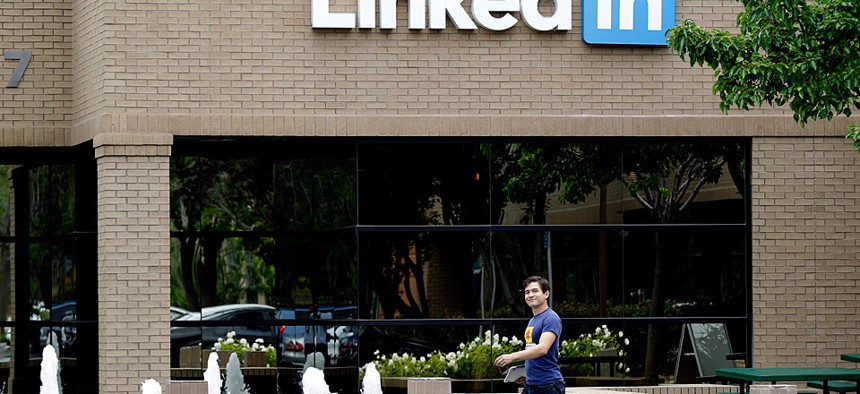
A man walks past the LinkedIn headquarters in Mountain View , Calif. Marcio Jose Sanchez/AP
How LinkedIn Taught Itself to Hire the Best People
"We made hiring the number one objective for everyone in the company in 2009, ahead of operations.”
Back in 2009, few engineers wanted to work for LinkedIn. It was a relative minnow as big Silicon Valley firms go, and not a particularly sexy one either. Compared to the glamorous lifestyle on offer at Google (free food! 20% time!) or Facebook (moving fast! breaking things!), LinkedIn seemed staid. “We couldn’t pay as much and didn’t have a brand,” says Steve Cadigan, who led LinkedIn’s human resources department from 2009 to the end of 2012.
Most companies would hire a recruitment agency to tackle a problem like this. For LinkedIn, that was out of the question—its reputation would have been in tatters. “I didn’t know if the product worked, and I couldn’t go to a search firm. I had to do it myself,” Cadigan says. “And every two weeks I had to get up in front of the company and give my own performance review.”
So Cadigan and LinkedIn decided to throw the weight of the entire company behind the effort. “We made hiring the number one objective for everyone in the company in 2009, ahead of operations,” Cadigan says. But even so, how would existing staff convince new people to join in the face of juicier offers from competitors? Cadigan says the key was figuring out what it is that tech talent really wants. When faced with a wealth of attractive options, they are most likely to want to work at a place where they can learn from somebody.
“So the first question was, ‘Do we have any tech luminaries?’” says Cadigan. The answer was no. The second question was whether they knew any such people. The team discovered they knew James Gosling, the creator of the Java programming language. They invited him in to talk to the staff and hang around. He started bringing his friends, and attracted fresh talent.
The second thing the team did was to “get out of recruiting talent and to building talent.” Half of LinkedIn’s technical hiring at the time came from fresh graduates, says Cadigan, going from zero to 200 interns in a matter of weeks. A lot of them were of high quality—some 90% of interns could expect to get hired by the firm.
Of course, a little massaging of the ego also helped. Cadigan says some of the things he told potential new hires included “Do you want to be engineer number 50 at LinkedIn or number 7,000 at Google?” And it helped that LinkedIn realized and was ok with the fact that people are more loyal to a project than to a company. So the biggest draw, he says, was to give them exciting projects: “Great talent wants to solve a problem that’s never been solved before.” Whether LinkedIn represents that or not is besides the point; it is telling the story that made it work.
Reprinted with permission from Quartz. The original story can be found here.






